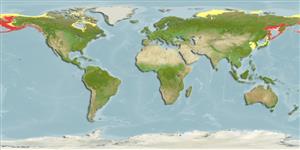Environment: milieu / climate zone / depth range / distribution range
বাস্তুসংস্থান
সামুদ্রিক তলদেশ বিহারী; গভীরতার পরিসীমা 4 - 320 m (Ref. 50550). Temperate
Arctic: Chukchi Sea. North Pacific: Hokkaido, Japan and Sea of Okhotsk and to Buldir Island in the Aleutian chain.
আকৃতি / ওজন / Age
Maturity: Lm ? range ? - ? cm
Max length : 45.0 cm FL পুরুষ/ লিঙ্গ অনিধর্ারিত ; (Ref. 115020)
পৃষ্ঠীয় কাঁটা (মোট ): 11 - 13; পৃষ্ঠীয় নরম পাখনা দন্ড (মোট ): 19-20; পায়ূ কাঁটা 0; পায়ূর নরম পাখনা্তুন্ড: 16 - 18. Scales on ventral scale row less than 1/2 the size of those on the dorsal scale row; fin membrane of spiny dorsal well incised; 4 preopercular spines; the 4th simple (Ref. 559).
Life cycle and mating behavior
পরিপক্কতা | প্রজনন | ডিম ছাড়া | ডিমসমূহ | ডিম্বধারন ক্ষমতা | শুককীট
Masuda, H., K. Amaoka, C. Araga, T. Uyeno and T. Yoshino, 1984. The fishes of the Japanese Archipelago. Vol. 1. Tokai University Press, Tokyo, Japan. 437 p. (text). (Ref. 559)
IUCN Red List Status (Ref. 130435)
Threat to humans
Harmless
Human uses
আরো তথ্য
সূত্র সংখ্যা এ্যাকুয়াকালচার (জলজ পালন) এ্যাকুয়াকালচার নকশা বংশ বংশানুগতিবিদ্যাElectrophoresesউতরাধিকার সুত্রে পাওয়া যোগ্যতারোগ প্রক্রিয়াজাতকরণ NutrientsMass conversion
সহযোগী ছবি সমূহStamps, Coins Misc.শব্দ ক্রোমোজোমের ধরণ গতি সাতাঁরের কায়দা ফুলকা এলাকাOtolithsমস্তিস্ক সমূহদৃষ্টি
হাতিয়ার
Special reports
Download XML
ইন্টারনেট সুত্র
Estimates based on models
Preferred temperature (Ref.
123201): -1.3 - 5.3, mean 0.9 °C (based on 783 cells).
Phylogenetic diversity index (Ref.
82804): PD
50 = 0.5156 [Uniqueness, from 0.5 = low to 2.0 = high].
Bayesian length-weight: a=0.00617 (0.00328 - 0.01160), b=3.11 (2.94 - 3.28), in cm total length, based on LWR estimates for this species & (Sub)family-body (Ref.
93245).
ট্রফিক পর্যায়ে (Ref.
69278): 3.5 ±0.54 se; based on food items.
স্থিতিস্থাপক (Ref.
120179): অত্যন্ত কম , সর্বনিম্ন প্রজন দ্বিগুনের সময় ১৪ বৎসর (Preliminary K or Fecundity.).
Fishing Vulnerability (Ref.
59153): Moderate vulnerability (40 of 100).
